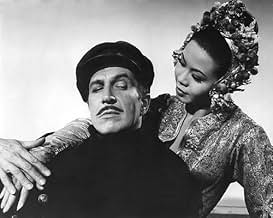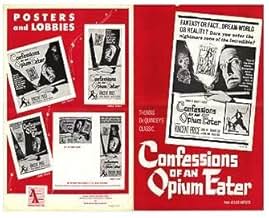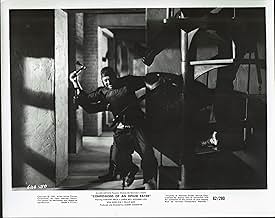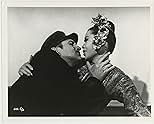Füge eine Handlung in deiner Sprache hinzuIn 19th-century San Francisco's Chinatown, American adventurer Gilbert De Quincey saves slave girls owned by the Chinese Tong factions.In 19th-century San Francisco's Chinatown, American adventurer Gilbert De Quincey saves slave girls owned by the Chinese Tong factions.In 19th-century San Francisco's Chinatown, American adventurer Gilbert De Quincey saves slave girls owned by the Chinese Tong factions.
- Regie
- Drehbuch
- Hauptbesetzung
- Lotus
- (as June Kim)
- Lo Tsen
- (as Caroline Kido)
- First Dancing Girl
- (as Joanne Miya)
- Auctionieer
- (as John Mamo)
Empfohlene Bewertungen
Price's De Quincy is a sailor, whose voice over is a Raymond Chandler meets De Quincy poetry, come to San Francisco after a long stay in "the orient", where he involves himself in the dubious world of human trafficking, particularly brides in China Town during the 1800's Tong Gang Wars. The film opens with a brutal scene involving screaming women thrown in a net like freshly caught tuna, and then a violent battle between two gangs on the beach as they try to deliver the kidnapped women to their fate.
Albert Zugsmith produced classics like "The Incredible Shrinking Man", "Written On The Wind", and "Touch Of Evil", along with directing many exploitation flicks, which this film veers into from time to time. The film is more in the Siejun Suzuki brand of wildly inventive, free wheeling pulpy expressionism, than Ed Wood kitschy ineptness. Despite the title the only scene involving opium is when Price takes some in order to get close to the women trafficking ring, and has a particularly impressive Lynchian circa Elephant-Man era hallucination scene (which is worth price of admission alone).
However the best scene comes when Price wakes up surrounded by guards and has to make a slow motion (cus he's high on opium) dash out of the den, and to the rooftops of china town. The scene is also completely silent, and truly marvelous in it's execution. I know slow motion action sequences where Greogiran chanting plays over sweat glistened A-listers shooting each other in mid air are common place now, but in Zugsmith's hands your reminded of excting an action sequence can be when it's done right. The plot is not particularly strong.
Why De Quincy is saving the girl, or what he is doing in China town at all, has many twists and turns, and leaves some gaps to be filled? But the direction, the suspense, and especially Price's performance make lines that would sound preposterous and almost Terrance Malick like in their stream of consciousness like "You wear as many masks as their are stars reflected in a gutter", sound as if he says them everyday. Such are the gifts of Price.
I was very pleased with this movie, that can be found easily on Youtube, though you might want to get a good copy to take in the fullness of Zugsmith's frames.There is a dreaminess and nightmarishness to all of the scenes, like opium was poured over a script to a lesser film, and this movie stumbled out of a smoke ridden room, rambling of dancing girls emerging from cages, crashes through windows, being swept to sea from sewer drains, and teetering on the edge of rooftops with vertigo at a snails pace, and feeling "the abbacus of fate has your number". Good times.
An adventurer (Vincent Price) in 19th century San Francisco becomes involved with Tong wars, slave auctions of Chinese girls and opium dens.
This is one of the most bizarre films I have ever seen. Even more jaw dropping that it got made in 1962. It is exploitation madness at it's best. Price however brings his great talent and class to make this a cut above other strange films made in the 1960s. All the Asian roles are played by real Asians such as busy character actors like Richard Loo and Philip Ahn. Linda Ho plays an evil "Mata Hari" type. She is deliciously nasty and smolderingly sexy in this part, probably the best role she ever had in her short film career. When Price settles down with a pipe in an opium den, there is a incredible druggy fight sequence all done in slow motion, it has to be seen to be believed. Another highlight is a wisecracking female Chinese dwarf (Alicia Li) who provides some wickedly funny quips. It ends with an auction scene where girls are sold for opium. They do some suggestive dances which most have seemed scandalous at the time. Price fans and anyone interested in something weird should seek this out.
Nominally based on Thomas De Quincy's CONFESSIONS OF AN ENGLISH OPIUM EATER, it seems a mildly incoherent, sloppily composed movie. On the other hand, there is the implication that this is all an opium dream, which would go a ways towards explaining the lack of sense. Given that the producer-director, Albert Zugsmith, was a hard-working man who had produced movies like Orson Welles' TOUCH OF EVIL and directed SAPPHO DARLIng, I'll come down in the middle. I think he intended this to be an opium dream, but given the script by Robert Hill, the remnants of the Production Code, and his own less than stellar talents, it's not a great success. Still, it provides a chance to see a lot of Studio Era actors like ichard Loo, Phillip Ahn, and Victor Sen Yung.
Highly recommended, naturally.
Wusstest du schon
- WissenswertesIndirectly led to the creation of the famed East West Players. Many of the Asian actors, including a young James Hong, were incensed after the only roles they were offered were "opium dope people and the prostitutes and so forth." After a petition to producer Albert Zugsmith fell on deaf ears, Hong co-founded the East West Players to give Asian-American actors more meaningful, non-stereotypical roles.
- PatzerThis film takes place in the 19th century, as stated, and seen in the townspeople's dress. But in the beach scene, a Thompson machine gun is used; this wasn't available until after 1918.
- Zitate
Gilbert De Quincey: [narration] When the dreams of the dark, idle, monstrous phenomenae move forever forward... wild, barbarous, capricious into the great yawning darkness... to be fixed for centuries in secret rooms. De Quincey, the artist? De Quincey, the pagan priest, to be worshipped, to be sacrificed. What is a dream and what is reality? Sometimes a man's life can be a nightmare; other times, cannot a nightmare be life? And the voices that I heard, were they the voices of some strange imitation of men in some strange, writhing jungle of my imagination? Was this opium or was it reality? Was I dead? Or I was I only beginning to live?
- VerbindungenEdited from Voodoo Woman (1957)
Top-Auswahl
- How long is Confessions of an Opium Eater?Powered by Alexa
Details
- Erscheinungsdatum
- Herkunftsland
- Sprache
- Auch bekannt als
- Confessions of an Opium Eater
- Drehorte
- Produktionsfirma
- Weitere beteiligte Unternehmen bei IMDbPro anzeigen
- Laufzeit1 Stunde 25 Minuten
- Farbe
- Seitenverhältnis
- 1.37 : 1






























